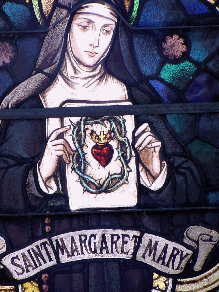 St. Margaret-Mary Alacoque was born in 1647 at Janots, the eastern quarter of L ‘Hautecour, a small town in Burgundy. Her father was a notary of some distinction, whose wife bore him seven children, of whom Margaret was the fifth. When she was about eight, her father died and she was sent to school with the Poor Clares at Charolles.
St. Margaret-Mary Alacoque was born in 1647 at Janots, the eastern quarter of L ‘Hautecour, a small town in Burgundy. Her father was a notary of some distinction, whose wife bore him seven children, of whom Margaret was the fifth. When she was about eight, her father died and she was sent to school with the Poor Clares at Charolles.
When she was twenty, pressure was put on her to marry, but, fortified by a vision of our Lord, she firmly refused. Not till she was twenty-two did she receive the sacrament of confirmation (it was then that she took the name of Mary), and thus armed she was able to withstand the final opposition of her family. Her brother Chrysostom furnished her dowry, and in June 1671 she entered the Visitation convent at Paray-le-Monial.
From that time “my divine Master urged me incessantly to ask for humiliations and mortifications”. They came unsought when she was appointed to assist in the infirmary. The infirmarian, Sister Catherine Marest, was temperamentally very different from her assistant: active, energetic, efficient, while Margaret-Mary was quiet, slow, and clumsy. During these two and a half years our Lord continually made Himself sensibly present to Margaret-Mary, often crowned with thorns, and on December 27, 1673, her devotion to His passion was rewarded with the first of the revelations.
She was kneeling alone at the grille before the Blessed Sacrament exposed on the altar, and all at once she felt herself, as she says, ‘invested’ by the divine Presence, and heard our Lord inviting her to take the place which St. John (it was his feast) had occupied at the Last Supper. He told her that the love of His heart must needs spread and manifest itself to men by means of her, and that He would reveal the treasures of its graces through her, His chosen instrument and the disciple of His Sacred Heart.
During the rule of Mother Greyfie, who succeeded Mother de Saumaise, St. Margaret-Mary alternately received great graces and underwent great trials, both interiorly and from her fellow-creatures. She was tempted to despair, vainglory and self-indulgence, and had a good deal of sickness.
The secret of her divine revelations was made known to the community in a rather dramatic (and for her embarrassing) way, being read out, presumably by accident, in the refectory in the course of a book written by Claud La Colombiere.
In 1687, a chapel was built at Paray in honour of the Sacred Heart, and the devotion began to be accepted in other convents of the Visitandines, and to be propagated here and there throughout France.
While serving a second term as assistant superior, St. Margaret-Mary was taken ill in October 1690. She asked for the last sacraments, saying, “I need nothing but God, and to lose myself in the heart of Jesus”. The priest came and began to administer the last rites; at the fourth anointing, of the lips, she died. St. Margaret-Mary Alacoque was canonized in 1920.
A more detailed history may be found in Butler’s Lives of the Saints, Burns & Oates 1956.
